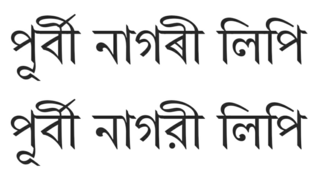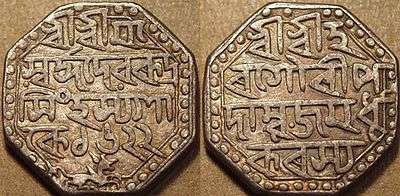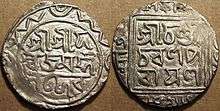Eastern Nagari script
| Eastern Nagari | |
|---|---|
 | |
| Type | |
| Languages | Assamese, Bengali, Bishnupriya Manipuri, Meitei, Sylheti, Santali, Kokborok, Garo, Hajong, Chakma, Rohingya, and others. |
Time period | c. 1100–present |
Parent systems | |
| Direction | Left-to-right |
| ISO 15924 |
Beng, 325 |
Unicode alias | Bengali |
| U+0980–U+09FF | |
|
[a] The Semitic origin of Brahmic scripts is not universally agreed upon. | |
| Brahmic scripts |
|---|
| The Brahmic script and its descendants |
|
Northern Brahmic
|
Eastern Nagari script, Bengali script, Assamese script, Bengali-Assamese script or Purbi script is the basis of the Bengali alphabet and the Assamese alphabet. Its usage is associated with the two main languages: Bengali and Assamese. Beside these two, the script has throughout history been used as writing system of other languages such as Bishnupriya Manipuri, Meitei Manipuri and Kokborok. Many other languages like Bodo, Karbi, Mising, Maithili, Angika etc. were also written in this script in the past.[1] Modern Sylheti is often written using this script as well. Hence, this script is the 5th most widely used writing system in the world.
Description



obverse: shri shri dônujomôrddôno debo,
reverse: shri chandi chôrôno pôrajôno.

In IAST: śāka 1127
śāke turaɡa yuɡmeṣe madhumāsa troyodaśe
kāmarūpā samāɡatyā turaska kṣayamāyayu
In Eastern Nagari (Assamese version): শাক ১১২৭
শাকে তুৰগ যুগ্মেষে মধুমাস ত্ৰোযোদশে
কামৰূপা সমাগত্যা তুৰস্ক ক্ষযমাযযু
Eastern Nagari is less blocky and present a more sinuous shaping. Eastern Nagari is derived from the precursor script Siddham. The modern Eastern Nagari script was formalized in 1778 when it was first typeset by Charles Wilkins. In addition to differences in how the letters are pronounced in the different languages, there are some minor typographical differences between the version of the script used for Assamese and Bengali languages.
The Eastern Nagari script was originally not associated with any particular regional language, but was prevalent as the main script in the eastern regions of Medieval India. The script was also used to write Sanskrit. Epics of Hindu scripture, including the Mahabharata or Ramayana, were written in older versions of the Eastern Nagari script in this region. After the medieval period, the use of Sanskrit as the sole written language gave way to Pali, and the vernacular dialects of Pali eventually evolved into Bengali, Assamese and other related languages. Sankardev used the script in the 15th and 16th centuries to compose his oeuvre in Assamese and Brajavali the language of the Bhakti poets; and before him, Madhava Kandali used it to write the Assamese Ramayana in the 14th century. It was also used by the later Ahom kings to write the Buranjis, the Ahom chronicles, in the Assamese language. There is a rich legacy of East sub-continental literature written in this script, which is still occasionally used to write Sanskrit today.
Clusters of consonants are represented by different and sometimes quite irregular characters; thus, learning to read the script is complicated by the sheer size of the full set of characters and character combinations, numbering about 500. While efforts at standardizing the script for the Bengali language continue in such notable centers as the Bangla Academy at Dhaka (Bangladesh) and Paschimbanga Bangla Akademi at Kolkata (West Bengal, India). It is still not quite uniform as yet, as many people continue to use various archaic forms of letters, resulting in concurrent forms for the same sounds. Among the various regional variations within this script, only the Bengali and Assamese variations exist today in the formalized system.
It seems likely that the standardization of the script will be greatly influenced by the need to typeset it on computers. Work has been underway since around 2001 to develop Unicode fonts, and it seems likely that it will split into two variants, traditional and modern.
Script
In this and other articles on Wikipedia dealing with the Assamese and Bengali languages, a Romanization scheme used by linguists specializing in Assamese and Bengali phonology is included along with IPA transcription.
Vowels
The script presently has a total of 11 vowel letters, used to represent the seven vowel sounds of Bengali and eight vowel sounds of Assamese, along with a number of vowel diphthongs. All of these vowel letters are used in both Assamese and Bengali. Some of the vowel letters have different sounds depending on the word, and a number of vowel distinctions preserved in the writing system are not pronounced as such in modern spoken Bengali or Assamese. For example, the script has two symbols for the vowel sound [i] and two symbols for the vowel sound [u]. This redundancy stems from the time when this script was used to write Sanskrit, a language that had a short [i] and a long [iː], and a short [u] and a long [uː]. These letters are preserved in the script with their traditional names of "short i" and "long i", etc., despite the fact that they are no longer pronounced differently in ordinary speech.
Two additional modified Vowels, অ' and অ্যা, are not considered letters of the Eastern Nagari script, but are often used in Assamese and Bengali (respectively) to represent certain vowels when the intended pronunciation would otherwise be ambiguous.
| Vowels | Vowel Diacritic symbol | Assamese | Bengali | Bishnupriya Manipuri | Meitei Manipuri | Sylheti | Hajong | Rabha | Rajbongsi |
|---|---|---|---|---|---|---|---|---|---|
| অ | - | ô | ô/o | ô | ô/a | o | o | ô | ô |
| অ’ | ’ | o | - | - | - | - | - | - | - |
| আ | া | a | a | a | a: | a | a | a | a |
| অ্যা/এ্যা | ্যা | - | æ | - | - | - | - | - | - |
| অৗ | ৗ | - | - | - | - | - | â | â | - |
| ই | ি | i | i | i | i | i | i | i | i |
| ই’ | ি’ | - | - | - | - | - | - | î | - |
| ঈ | ী | i | i | i | - | ī | - | - | (i) |
| উ | ু | u | u | u | u | u | u | u | u |
| উ’ | ু’ | - | - | - | - | - | - | â | - |
| ঊ | ূ | u | u | u | - | ū | - | - | (u) |
| ঋ | ৃ | ri | ri | ri | - | ri | - | - | ri |
| ৠ | ৄ | rii | rii | - | - | - | - | - | - |
| ঌ | ৢ | li | li | - | - | - | - | - | - |
| ৡ | ৣ | lii | lii | - | - | - | - | - | - |
| এ | ে | ê | e/ê | e | e | ê | e | e | ê |
| এ’ | ে’ | e | - | - | - | - | - | - | - |
| ঐ | ৈ | ôi | ôi | ôi | ei | oi | oi | - | ôi |
| ও | ো | û | o | u | o/ô | - | ô | o | o |
| ঔ | ৌ | ôu | ôu | ôu | ou | ou | ôu | - | ôu |
Vowel signs can be used in conjunction with consonants to modify the pronunciation of the consonant (here exemplified by ক, kô). When no vowel Diacritic symbol is written, then the vowel "অ" (ô) is the default inherited vowel for the consonant. To specifically denote the absence of a vowel, a hôsôntô (্) may be written underneath the consonant.
Consonants
The names of the consonant letters in Eastern Nagari are typically just the consonant's main pronunciation plus the inherent vowel "অ" ô. Since the inherent vowel is assumed and not written, most letters' names look identical to the letter itself (e.g. the name of the letter "ঘ" is itself ঘ ghô, not gh). Some letters that have lost their distinctive pronunciation in Modern Assamese and Bengali are called by a more elaborate name. For example, since the consonant phoneme /n/ can be written ন, ণ, or ঞ (depending on the spelling of the particular word), these letters are not simply called nô; instead, they are called "dental nô", "cerebral nô" and niô. Similarly, the phoneme /ʃ/ in Bengali and /x/ in Assamese can be written as "palatal shô/xhô" শ , "cerebral shô/xhô" ষ, or "dental sô/xô" স, depending on the word.
| Consonant | Assamese | Bengali | Bishnupriya Manipuri | Meitei Manipuri | Sylheti | Hajong | Maithili | |
|---|---|---|---|---|---|---|---|---|
| ক | kô | kô | kô | kô | xo | ko | kô | |
| খ | khô | khô | khô | khô | xo | kho | khô | |
| গ | gô | gô | gô | gô | go | go | gô | |
| ঘ | ghô | ghô | ghô | ghô | go | gho | ghô | |
| ঙ | ungô | ngô | ngô | ngô | - | ngo | ngo | |
| চ | sô | cô | cô | cô | so | co | cô | |
| ছ | sô | chô | chô | - | so | so | - | |
| 𑒕 | - | - | - | - | - | - | chô | |
| জ | zô | jô | jô | jô | zo | jo | jô | |
| ঝ | zhô | jhô | jhô | jhô | zo | jho | - | |
| 𑒗 | - | - | - | - | - | - | 𑒗 | |
| ঞ | niô | nô | nô | - | - | - | ||
| ট | tô | ţô | ţô | - | to | - | ||
| 𑒙 | - | - | - | - | - | - | - | |
| ঠ | thô | ţhô | ţhô | - | to | - | ||
| ড | dô | đô | đô | - | do | - | dô | |
| ড় | rô | ŗô | ŗô | - | ŗo | - | ||
| ঢ | dhô | đhô | đhô | - | do | - | dô | |
| ঢ় | rhô | ŗhô | ŗhô | - | ro | - | ||
| ণ | nô | nô | nô | - | no | - | - | |
| ত | tô | tô | tô | tô | ṭo | to | tô | |
| থ | thô | thô | thô | thô | ṭo | tho | thô | |
| দ | dô | dô | dô | dô | ḍo | do | dô | |
| ধ | dhô | dhô | dhô | dhô | ḍo | dho | dhô | |
| ন | nô | nô | nô | nô | no | no | nô | |
| প | pô | pô | pô | pô | fo | po | ||
| ফ | fô | phô | fô | fô | fo | fo | - | |
| 𑒙 | - | - | - | - | - | - | phô | |
| ব | bô | bô | bô | bô | bo | bo | rô | |
| ভ | bhô | bhô | bhô | bhô | bo | bho | bhô | |
| ম | mô | mô | mô | mô | mo | mo | ||
| য | zô | jô | jô | - | zo | - | jô | |
| য় | yô | yô | yô | yô | - | yo | yô | |
| র | (wô) | rô | rô | rô | ro | wõ | ||
| ৰ | rô | (rô) | - | - | ro | ro | rô | |
| ল | lô | lô | lô | lô | lo | lo | ||
| 𑒪 | - | - | - | - | - | - | lô | |
| ৱ | wô | - | wô | wô | o | wo | - | |
| শ | xô | şô | şô | - | - | - | shô | |
| ষ | xô | şşô | şşô | - | - | - | sshô | |
| স | xô | şô | sô | sô | şo | - | sô | |
| হ | hô | hô | hô | hô | ho | ho | - | |
| 𑒯 | - | - | - | - | - | - | hô |
Digits
| Western Arabic numerals | 0 | 1 | 2 | 3 | 4 | 5 | 6 | 7 | 8 | 9 |
|---|---|---|---|---|---|---|---|---|---|---|
| Eastern Nagari numerals | ০ | ১ | ২ | ৩ | ৪ | ৫ | ৬ | ৭ | ৮ | ৯ |
| Assamese names | xuinno | ek | dui | tini | sari | pãs | soy | xat | ath | no |
| শূন্য | এক | দুই | তিনি | চাৰি | পাঁচ | ছয় | সাত | আঠ | ন | |
| Bengali names | shunnô | æk | dui | tin | char | pãch | chhôy | shat | aţ | nôy |
| শূন্য | এক | দুই | তিন | চার | পাঁচ | ছয় | সাত | আট | নয় | |
| Meitei names | shunya | ama | ani | ahum | mari | manga | taruk | taret | nipa:n | ma:pan |
| শুন্য | অমা | অনি | অহুম | মরি | মঙা | তরূক | তরেৎ | নীপান | মাপন | |
| Sylheti names | shuinno | ex | dui | tin | sair | fas | soe | shat/hat | aŧ | noe |
| ꠡꠥꠁꠘ꠆ꠘ꠩ | ꠄꠇ | ꠖꠥꠁ | ꠔꠤꠘ | ꠌꠣꠁꠞ | ꠙꠣꠌ | ꠍꠄ | ꠡꠣꠔ/ꠢꠣꠔ | ꠀꠐ | ꠘꠄ | |
| Maithili names | shūnyô | ek | du | tin | chari | pãch | chhô: | sat | aţh | nôu |
| শূন্য | এক | দু | তিন | চাৰি | পাঁচ | ছঃ | সাত | আঠ | নউ |
Eastern Nagari in Unicode
The Unicode block for Eastern Nagari script, called Bengali, is U+0980–U+09FF:
| Bengali[1][2] Official Unicode Consortium code chart (PDF) | ||||||||||||||||
| 0 | 1 | 2 | 3 | 4 | 5 | 6 | 7 | 8 | 9 | A | B | C | D | E | F | |
| U+098x | ঀ | ঁ | ং | ঃ | অ | আ | ই | ঈ | উ | ঊ | ঋ | ঌ | এ | |||
| U+099x | ঐ | ও | ঔ | ক | খ | গ | ঘ | ঙ | চ | ছ | জ | ঝ | ঞ | ট | ||
| U+09Ax | ঠ | ড | ঢ | ণ | ত | থ | দ | ধ | ন | প | ফ | ব | ভ | ম | য | |
| U+09Bx | র | ল | শ | ষ | স | হ | ় | ঽ | া | ি | ||||||
| U+09Cx | ী | ু | ূ | ৃ | ৄ | ে | ৈ | ো | ৌ | ্ | ৎ | |||||
| U+09Dx | ৗ | ড় | ঢ় | য় | ||||||||||||
| U+09Ex | ৠ | ৡ | ৢ | ৣ | ০ | ১ | ২ | ৩ | ৪ | ৫ | ৬ | ৭ | ৮ | ৯ | ||
| U+09Fx | ৰ | ৱ | ৲ | ৳ | ৴ | ৵ | ৶ | ৷ | ৸ | ৹ | ৺ | ৻ | ৼ | ৽ | ৾ | |
| Notes | ||||||||||||||||
External links
Notes
- ↑ Prabhakara, M S Scripting a solution, The Hindu, 19 May 2005.
References
- Bora, Mahendra (1981). The Evolution of Assamese Script. Jorhat, Assam: Assam Sahitya Sabha.
